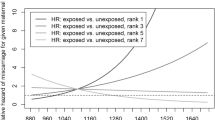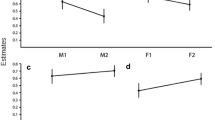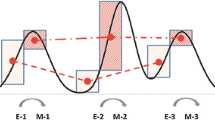Abstract
We present results of a 10-year study of free-ranging gray-footed chacma baboons (Papio ursinus griseipes) in the Okavango Delta of Botswana. The majority of deaths among adult females and juveniles were due to predation, while infants were more likely to die of infanticide. There were strong seasonal effects on birth and mortality, with the majority of conceptions occurring during the period of highest rainfall. Mortality due to predation and infanticide was highest during the 3-mo period when flooding was at its peak, when the group was more scattered and constrained to move along predictable routes. The reproductive parameters most likely to be associated with superior competitive ability—interbirth interval and infant growth rates—conferred a slight fitness advantage on high-ranking females. However, it was counterbalanced by the effects of infanticide and predation. Infanticide affected high- and low-ranking females more than middle-ranking females, while predation affected females of all ranks relatively equally. As a result, there were few rank-related differences in estimated female lifetime reproductive success.
Similar content being viewed by others
References
Altmann, S. A., and Altmann, J. (1970). Baboon Ecology: African Field Research, University of Chicago Press, Chicago.
Altmann, J., Hausfater, G., and Altmann, S. A. (1988). Determinants of reproductive success in savannah baboons Papio cynocephalus. In Clutton-Brock, T. H. (ed.), Reproductive Success, University of Chicago Press, Chicago, pp. 403-418.
Barton, R. A. (1993). Sociospatial mechanisms of feeding competition in female olive baboons, Papio anubis. Anim. Behav. 46: 791-802.
Barton, R. A., Byrne, R. W., and Whiten, A. (1996). Ecology, feeding competition and social structure in baboons. Behav. Ecol. Sociobiol. 38: 321-329.
Barton, R. A., and Whiten, A. (1993). Feeding competition among female olive baboons, Papio anubis. Behav. Ecol. Sociobiol. 38: 321-329.
Berman, C. M. (1980). Early agonistic experience and rank acquisition among free-ranging infant rhesus monkeys. Int. J. Primatol. 1: 152-170.
Brown, D. (1988). Components of lifetime reproductive success. In Clutton-Brock, T. H. (ed.), Reproductive Success, University of Chicago Press, Chicago, pp. 439-453.
Brown, G. R., and Silk, J. B. (2002). Reconsidering the null hypothesis: Is maternal rank associated with birth sex ratios in primate groups? Proc. Nat. Acad. Sci. U.S.A. 99: 11252-11255.
Bühl, A., and Zöfel, P. (2002). SPSS 11. Einführung in die moderne Datenanalyse unter Windows, Pearson Studium, Munich.
Bulger, J., and Hamilton, W. J. (1987). Rank and density correlates of inclusive fitness measures in a natural chacma baboon (Papio ursinus) population. Int. J. Primatol. 8: 635-650.
Busse, C. (1982). Leopard and lion predation upon chacma baboons living in the Moremi Wildlife Reserve. Botswana Notes Rec. 12: 15-21.
Busse, C. D. (1984). Spatial structure of chacma baboon groups. Int. J. Primatol. 5: 247-261.
Cheney, D. L. (1992). Within-group cohesion and inter-group hostility: The relation between grooming distributions and inter-group competition among female primates. Behav. Ecol. 3: 334-345.
Cheney, D. L., Andelman, S. J., Seyfarth, R. M., and Lee, P. C. (1988). The reproductive success of vervet monkeys. In Clutton-Brock, T. H. (ed.), Reproductive Success, University of Chicago Press, Chicago, pp. 384-402.
Cheney, D. L., and Seyfarth, R. M. (1990). How Monkeys See The World: Inside The Mind Of Another Species, University of Chicago Press, Chicago.
Cheney, D. L., and Wrangham, R. W. (1987). Predation. In Smuts, B. B., Cheney, D. L., Seyfarth, R. M., Wrangham, R. W., and Struhsaker, T. T. (eds.), Primate Societies, University of Chicago Press, Chicago, pp. 227-239.
Combes, S. L., and Altmann, J. (2001). Status change during adulthood: Life-history byproduct or kin-selection based on reproductive value? Proc. R. Soc. Lond. B 268: 1367-1373.
Condit, V., and Smith, E. O. (1994). Predation on a yellow baboon (Papio cynocephalus cynocephalus) by a lioness in the Tana River National Primate Reserve, Kenya. Am. J. Primatol. 33: 57-64.
Cowlishaw, G. (1994). Vulnerability to predation in baboon populations. Behaviour 131: 293-304.
Cowlishaw, G. (1999). Ecological and social determinants of spacing behaviour in desert baboon groups. Behav. Ecol. Sociobiol. 45: 67-77.
Creel, S., and Creel, N. M. (2002). The African Wild Dog: Behavior, Ecology, and Conservation, Princeton University Press, Princeton.
Creel, S. R., and Waser, P. M. (1997). Variation in reproductive suppression among dwarf mongooses: Interplay between mechanisms and evolution. In Solomon, N. G., and French, J. A. (eds.), Cooperative Breeding in Mammals, Cambridge University Press, Cambridge, pp. 150-170.
DeVore, I., and Hall, K. R. L. (1965). Baboon ecology. In DeVore, I. (ed.), Primate Behavior, Holt, Rinehart, and Winston, New York, pp. 18-52.
Ellery, W. N., Ellery, K., and McCarthy, T. S. (1993). Plant distribution in island of the Okavango Delta, Botswana: Determinants and feedback interactions. Afr. J. Ecol. 31: 118-134.
Fairbanks, L. A. (1988). Vervet monkey grandmothers: Interactions with infant grandoffspring. Int. J. Primatol. 9: 425-441.
Fairbanks, L. A., and McGuire, M. T. (1986). Age, reproductive value, and dominance-related behaviour in vervet monkey females: Cross-generational influences on social relationships and reproduction. Anim. Behav. 34: 1710-1721.
Fischer, J., Hammerschmidt, K., Cheney, D. L., and Seyfarth, R. M. (2002). Acoustic features of male baboon loud calls: Influences of context, age, and individuality. J. Acoust. Soc. Am. 111: 1465-1474.
Fischer, J., Hammerschmidt, K., Seyfarth, R. M., and Cheney, D. L. (2001). Acoustic features of female chacma baboon barks. Ethology 107: 33-54.
Grafen, A. (1988). On the uses of data on lifetime reproductive success. In Clutton-Brock, T. H. (ed.), Reproductive Success, University of Chicago Press, Chicago, pp. 454-471.
Hall, K. R. L., and DeVore, I. (1965). Baboon social behavior. In DeVore, I. (ed.), Primate Behavior, Holt, Rinehart, and Winston, New York, pp. 53-110.
Hamilton, W. J., Buskirk, R. E., and Buskirk, W. H. (1976). Defense of space and resources by chacma (Papio ursinus) baboon troops in an African desert and swamp. Ecology 57: 1264-1272.
Hauser, M. D., and Harcourt, A. H. (1992). Is there sex-biased mortality in primates? Folia primatol. 58: 47-52.
Hill, R. A., and Dunbar, R. I. M. (1998). An evaluation of the roles of predation rate and predation risk as selective pressures on primate grouping behaviour. Behaviour 135: 411-430.
Isbell, L. A. (1991). Contest and scramble competition: Patterns of female aggression and ranging behavior among primates. Behav. Ecol. 2: 143-155.
Janson, C. (1998). Testing the predation hypothesis for vertebrate sociality: Prospects and pitfalls. Behaviour 135: 389-410.
Janson, C. H. (1988). Intra-specific food competition and primate social structure: A synthesis. Behaviour 105: 1-17.
Janson, C. H., and van Schaik, C. P. (2000). The behavioral ecology of infanticide by males. In van Schaik, C., and Janson, C. (eds.), Infanticide by Males and Its Implications, Cambridge University Press, Cambridge, pp. 469-494.
Johnson, S. E. (2001). Modeling the Trade-off Between Energy Acquisition and Predation Risk: Effects on Individual Variation in Growth and Mortality Among Baboons(Papio hamadryas ursinus) in the Okavango Delta, Botswana, PhD Dissertation, University of New Mexico.
Johnson, S. E. (2003). Life history and the competitive environment: Trajectories of growth, maturation, and reproductive output among Chacma baboons. Am. J. Phys. Anthropol. 120: 83-98.
Kitchen, D. M., Cheney, D. L., and Seyfarth, R. M. (in press). Factors mediating inter-group encounters in savanna baboons (Papio cynocephalus ursinus). Behaviour.
Lee, P. C., and Johnson, J. A. (1992). Sex differences in alliances, and the acquisition and maintenance of dominance status among immature primates. In Harcourt, A., and de Waal, F. (eds.), Coalitions and Alliances in Primates and Other Animals, Oxford University Press, Oxford, pp.391-414.
Mitani, J. C., Sanders, W. J., Lwanga, J. S., and Windfelder, T. L. (2001). Predatory behavior of crowned hawk-eagles (Stephanoaetus coronatus) in Kibale National Park, Uganda. Behav. Ecol. Sociobiol. 49: 187-195.
O'Riain, M. J., Bennett, N. C., Brotherton, P. N., McIlrath, G., and Clutton-Brock, T. H. (2000). Reproductive suppression and inbreeding avoidance in wild populations of cooperatively breeding meerkats (Suricata suricatta). Behav. Ecol. Sociobiol. 48: 471-477.
Packer, C., Collins, D. A., Sindimwo, A., and Goodall J. (1995). Reproductive constraints on aggressive competition in female baboons. Nature 373: 60-63.
Palombit, R., Cheney, D., Seyfarth, R., Rendall, D., Silk, J., Johnson, S., and Fischer, J. (2000). Male infanticide and defense of infants in chacma baboons. In van Schaik, C., and Janson, C. (eds.), Infanticide by Males and Its Implications, Cambridge University Press, Cambridge, pp. 123-152.
Palombit, R. A., Cheney, D. L., and Seyfarth, R. M. (2001). Female-female competition for male “friends” in wild chacma baboons (Papio cynocephalus ursinus). Anim. Behav. 61: 1159-1171.
Palombit, R. A., Seyfarth, R. M., and Cheney, D. L. (1997). The adaptive value of “friendships” to female baboons: Experimental and observational evidence. Anim. Behav. 54: 599-614.
Pereira, M. (1988). Agonistic interactions of juvenile savanna baboons: I. Fundamental features. Ethology 79: 195-217.
Pinheiro, J. C., and Bates, D. M. (2000). Mixed-effect Models in S and S-Plus, Springer, New York.
Rhine, R. J., Wasser, S. K., and Norton, G. W. (1988). Eight-year study of social and ecological correlates of mortality among immature baboons of Mikumi National Park, Tanzania. Am. J. Primatol. 16: 199-212.
Ron, T., Henzi, S. P., and Motro, U. (1996). Do female chacma baboons compete for a safe spatial position in a southern woodland habitat? Behaviour 133: 475-490.
Roodt, V. (1998). Trees and Shrubs of the Okavango Delta: Nutritional Uses and Nutritional Value, Shell Oil Botswana, Gaborone, Botswana.
Ross, K. (1987). Okavango: Jewel of the Kalahari, Macmillan, New York.
Silk, J. B. (1983). Local resource competition and facultative adjustment of sex ratios in relation to competitive abilities. Am. Nat. 121: 56-66.
Silk, J. B. (1987). Activities and feeding behavior of free ranging pregnant baboons. Int. J. Primatol. 8: 593-613.
Silk, J. B. (1993). The evolution of social conflict among female primates. In Mason, W. A., and Mendoza, S. P. (eds.), Primate Social Conflict, State University of New York Press, Albany, pp. 49-83.
Silk, J. B., Alberts, S. C., and Altmann, J. (2003). Patterns of coalition formation by adult female baboons in Amboseli, Kenya. Anim. Behav.
Silk, J. B., Seyfarth, R. M., and Cheney, D. L. (1999). The structure of social relationships among female baboons in the Moremi Reserve, Botswana. Behaviour 136: 679-703.
Smuts, B., and Nicolson, N. (1989). Reproduction in wild female olive baboons. Am. J. Primatol. 19: 229-246.
Stanford, C. B. (2002). Avoiding predators: Expectations and evidence in primate antipredator behavior. Int. J. Primatol. 23: 741-757.
Sterck, E. H. M., Watts, D. P., and van Schaik, C. P. (1997). The evolution of female social relationships in nonhuman primates. Behav. Ecol. Sociobiol. 41: 291-309.
Struhsaker, T. T. (1975). The Red Colobus Monkey, University of Chicago Press, Chicago.
Sugiyama, Y., and Ohsawa, H. (1982). Population dynamics of Japanese monkeys with special reference to the eeftcs of artificial feeding. Folia Primatol. 39: 238-263.
Tabachnik, B. G., and Fidell, L. S. (2001). Using Multivariate Statistics, Allyn and Bacon, Boston.
van Noordwijk, M. A., and van Schaik, C. P. (1987). Competition among female long-tailed macaques, Macaca fascicularis. Anim. Behav. 35: 577-589.
van Noordwijk, M. A., and van Schaik, C. P. (1999). The effects of dominance rank and group size on female lifetime reproductive success in wild long-tailed macaques, Macaca fascicularis. Primates 40: 105-130.
van Schaik, C. P. (1983). Why are diurnal primates living in groups? Behaviour 87: 120-144.
van Schaik, C. P. (1989). The ecology of social relationships amongst female primates. In Standen, V., and Foley, R. A. (eds.), Comparative Socioecology: The Behavioural Ecology of Humans and Other Animals, Blackwell, Oxford, pp. 195-218.
Whitten, P. L. (1983). Diet and dominance among female vervet monkeys (Cercopithecus aethiops). Am. J. Primatol. 5: 139-159.
Wrangham, R. W. (1980). An ecological model of female-bonded primate groups. Behaviour 75: 262-300.
Wrangham, R. W. (1981). Drinking competition in vervet monkeys. Anim. Behav. 29: 904-910.
Zinner, D., and Paleaz, F. (1999). Verreaux's eagles (Aquila verreauxi) as potential predators of hamadryas baboons (Papio hamadryas hamadryas) in Eritrea. Am. J. Primatol. 47: 61-66.
Author information
Authors and Affiliations
Corresponding author
Rights and permissions
About this article
Cite this article
Cheney, D.L., Seyfarth, R.M., Fischer, J. et al. Factors Affecting Reproduction and Mortality Among Baboons in the Okavango Delta, Botswana. International Journal of Primatology 25, 401–428 (2004). https://doi.org/10.1023/B:IJOP.0000019159.75573.13
Issue Date:
DOI: https://doi.org/10.1023/B:IJOP.0000019159.75573.13




